Cardamon: The Seeds of Paradise
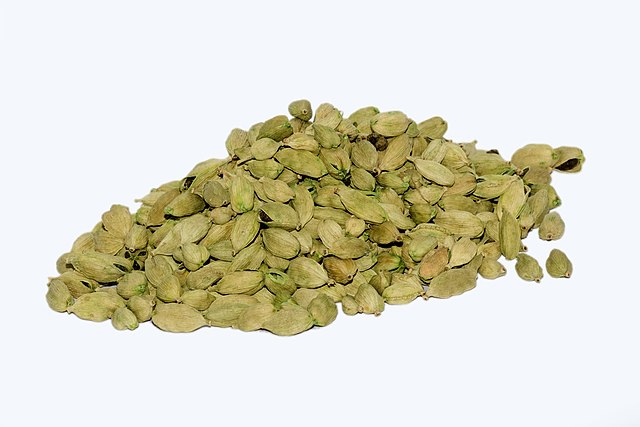
By: Habeeb Salloum/Arab America Contributing Writer
No one who has visited a home in the Arabian Peninsula will forget the aroma of cardamom scented coffee which seems to permeate the whole atmosphere. A characteristic of that part of the world since time immemorial, this favorite drink of the Arabs usually leaves a lasting imprint on a foreign guest. Most travelers do not often forget the highly aromatic and somewhat sweet gingery-lemon flavor of the cardamom.
Sometimes called ‘Seeds of Paradise’, cardamom is an exotic spice, native to India and Sri Lanka where it is still found in the wild. Over 4000 years ago it was mentioned in the sacred texts of India and 700 years before the birth of Christ it was believed to have been grown as an ornamental plant in the gardens of the Babylonian kings. In later centuries, adventurous Arab spice traders brought it to the ancient Egyptian, Greek and Roman worlds. For hundreds of years, it was a much sought after commodity, especially for use as a perfume.
Both Greece and Rome never knew how to obtain this spice directly from its land of origin. Using wisdom and cunning, the Arabs protected their lucrative spice trade. They deceived historians from Herodotus to Pliny into believing that cardamom was the product of Arabia when, in fact, they were importing it from India.
For centuries, until the discovery of the Americas, the Indian subcontinent was virtually the only place where cardamom was produced. Even today, it is still chiefly grown in that part of the world, but its cultivation has also spread to Central America and Jamaica. However, its use in food is almost worldwide. In addition to it being extensively used in India and Sri Lanka, it is used on a wide scale in the Middle East and, surprisingly, in the Scandinavian countries.
There are several types of cardamom seeds, the most important being Ceylon, Malabar, and Mysore. All are the dried fruit of elettaria cardamomun, a perennial large bushy reed-like plant belonging to the ginger family.
Only thriving in certain tropical climates, the tree grows up to 12 feet high. It has long lance-shaped leaves resembling palm fronds and produces colorful Flowers. After about 3 years it begins to bear fruit – pods from 1/4 to 1 inch in length. These come in two types: black or dark brown, and green, the latter being the most common. These are harvested when still pale, before becoming fully ripe and turning to a deep yellow. Each pod contains from 6 to 20 irregular light reddish-brown seeds which are the cardamom spice.
The pods are dried naturally or bleached and dried in the sun or by artificial means. After drying, the unbleached turn to a greenish yellow and the bleached become creamy white. They can be purchased in either color but the smaller pods in both varieties are the most sought after, since they are considered to have the strongest flavor and aroma.
In every part of the globe, real cardamom, which is one of the most precious spices in the world, is expensive. Hence, a number of related spices, quite different in appearance and taste are often sold as cardamom. However, to ones who know the spice well they are a gross imitation.
Containing calcium oxalate, cellulose, pentosans, protein, silica, starch, sugar, mineral elements and, volatile and fixed oils, cardamom has a reputation for being stimulating and antiseptic. In the midst of antiquity, Assyrian doctors knew that it had medical properties and in the Middle Ages a spicy powder, with cardamom as an important ingredient, was prescribed for headaches to clarify sight and as an aid to digestion. The Chinese have always classified cardamom as a medical drug and in India a tea, used for the relief of colds and chest congestions, is made from the spice. In the countries of the Arabian Peninsula, which are second only to India in the consumption of cardamom, the people believe that it increases energy and is useful in the digestion of food.
The inhabitants of those parts of Asia where cardamom is used extensively say that it is a marvelous deodorant. For neutralizing the smell of garlic and freshening the breath, a few pods are sucked upon and slowly chewed, allowing the flavor to linger in the mouth. At times, a pod is combined with a few fennel seeds and a whole clove to produce an even more effective breath freshener.
Today, throughout the world, cardamom seeds are used in a wide range of foods. In India and the Arab countries, they are used to flavor coffee, tea, soups, meat and vegetable dishes, sherbets, and sweets. In addition, they form an important ingredient in curries and ras el-hanout – a Moroccan mixture of spices. The Scandinavians use cardamom to flavor bakery products such as biscuits, breads, cakes, and related pastries. In a number of countries, besides being used in perfumes and soaps, it is added as a seasoning to hamburgers and used to give an exotic taste to confections, jellies, liqueurs, pickles, puddings and punches.
Since their flavor is so pungent, cardamom seeds should be used in moderation. If used in small quantities, they give food in exquisite and delicious touch. They blend well with fennel, cinnamon and cloves and add a sweet-spicy element to the dishes in which they are added. On the other hand, for soups and stews, if cardamom is not available, coriander or ginger may be substituted.
The seeds can be purchased whole or ground. However, they should never be bought in the latter form since soon after being crushed, they rapidly lose their essential oils. To retain their aromatic aroma and flavor, the seeds should not be taken out of the pod until ready for the pot.
To prepare them for use, the pods should be cracked with a small knife or fingernail. The seeds can then be removed, and the skin discarded. For the utmost in savor-ness and aroma, the seeds must be immediately ground and used. About 8 large or 12 small pods make about a 1/2 teaspoon of ground cardamom.
The following recipes which include these freshly ground so-called ‘Seeds of Paradise’ are based mostly on Indian and Middle Eastern dishes. They are a sample of how this versatile spice adds aroma and a unique taste to food and drink.
Cardamom Coffee
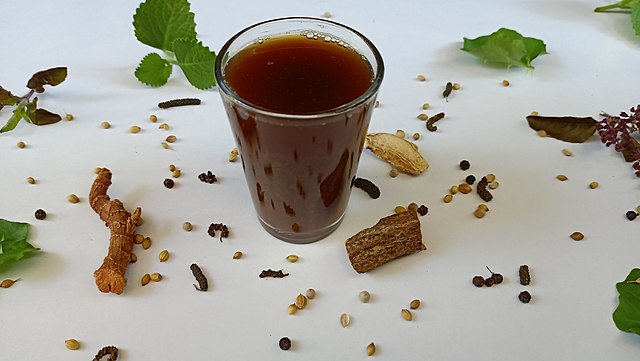
Serves 4
1 tablespoon unroasted coffee
1 1/2 cups cold water
1/2 teaspoon freshly ground cardamom seeds
- In a heavy frying pan and roast the coffee over high heat, stirring constantly until the coffee barely begins to brown, then remove, allow to cool and coarsely grind.
- Place the water in a pot and bring to a boil, then add the coffee and brew over medium heat for 10 minutes.
- Remove from the heat and pour slowly into a small coffee pot, making sure the grounds remain in the first pot, then add the cardamom and bring to a boil.
- Brew for 5 minutes, then pour through a strainer into tiny demitasse cups and serve.
Cardamom Tea
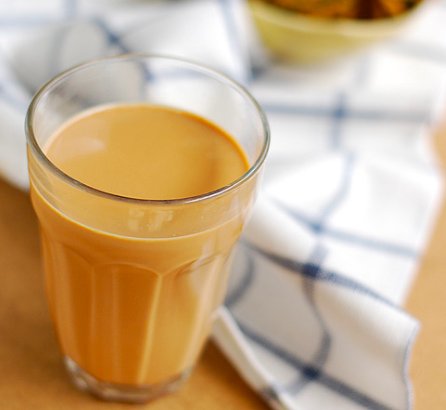
Serves 6
3 cups water
1 teaspoon black tea
1 small cinnamon stick
4 cardamom seeds, whole – cracked
1/2 teaspoon fennel seeds
1 cup milk
1 tablespoon sugar
- Place the water, tea, cinnamon stick, cardamom, and fennel seeds in a pot and bring to a boil, then cover and simmer over medium heat for 10 minutes.
- Add the milk and sugar, bring to a boil, then remove from the heat.
- Strain into glasses and serve.
Eggplant Appetizer
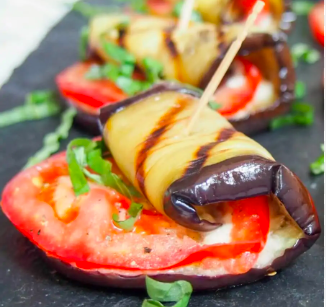
Serves 6
1 large eggplant, about 2-pounds
2 tablespoons butter
1 medium onion, finely chopped
3 cloves garlic, crushed
1 small hot pepper, seeded and finely chopped
3/4 teaspoon ground ginger
1/2 teaspoon freshly ground cardamom seeds
1/2 teaspoon salt
1/4 teaspoon black pepper
2 tablespoons lemon juice
2 tablespoons finely chopped parsley
- Bake eggplant in a 350o F preheated oven for about 1 1/4 hours or until the skin becomes crisp, then remove and allow to cool.
- Peel and mash, then set aside.
- In a frying pan, melt the butter and sauté the onion, garlic, and hot pepper over medium heat for 15 minutes or until golden brown, then stir in the eggplant, ginger, cardamom, salt and pepper and stir-fry for 5 minutes.
- Stir in the lemon juice, then place on a serving platter and decorate with the parsley, just before serving warm.
Cardamom Flavored Chickpea and Rice Soup
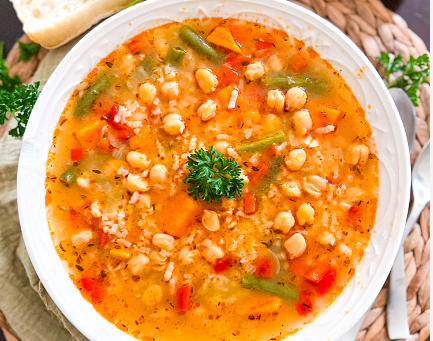
Serves 8
4 tablespoons olive oil
2 medium onions, chopped
4 cloves garlic, crushed
1 small hot pepper, seeded and finely chopped
1 can chickpeas (19 oz. 540 mL), with its water
1/3 cup brown rice, rinsed
1 teaspoon freshly ground cardamom seeds
1 teaspoon ginger
1 teaspoon cinnamon
1/2 teaspoon salt
1/2 teaspoon black pepper
6 cups water
- In a saucepan, heat the oil and sauté the onions, garlic, and hot pepper over medium heat for 12 minutes, then stir in the remaining ingredients and bring to a boil.
- Cook over medium heat for 45 minutes or until the rice is cooked, stirring occasionally then serve hot.
Note: Add more salt if desired.
Cardamom Fruit Salad
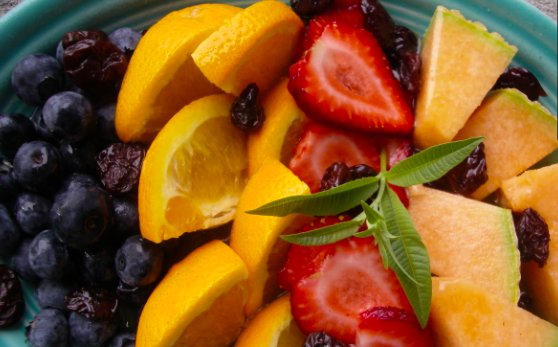
Serves 8
1 medium cantaloupe (about 2-pounds), peeled and cut into 1/2 -inch cubes
2 medium oranges, peeled and sectioned, then sections cut in half
2 medium apples, peeled, cored, and cut into 1/2- inch cubes
1/2 cup raisins, rinsed
1/2 cup honey
2 tablespoons water
1/2 teaspoon freshly ground cardamom seeds
4 tablespoons lemon juice
- Place the cantaloupe, oranges, apples, and raisins in a serving bowl, then set aside.
- In a saucepan, bring the honey, water and cardamom to a boil, then remove from the heat and allow to cool.
- Stir in the honey mixture and lemon juice in the fruits, then toss and serve immediately.
Cardamom Flavored Rice
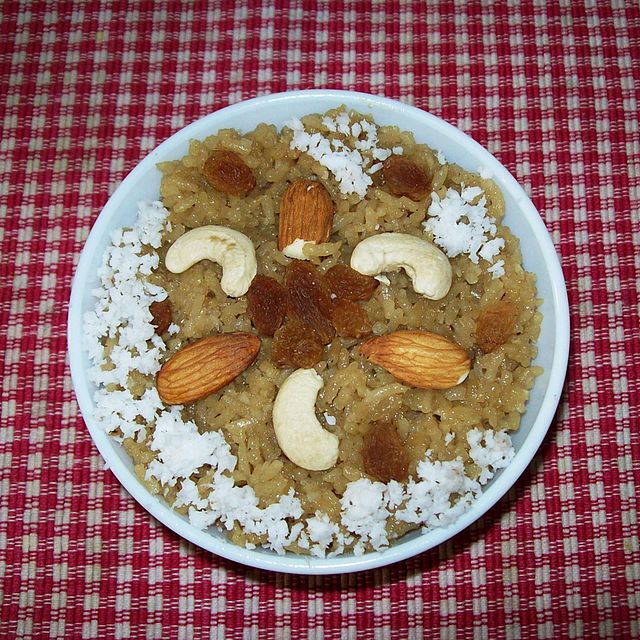
Serves 6
4 tablespoons butter
1/2 cup slivered almonds
1 cup brown rice, rinsed
1/4 cup raisins, rinsed
2 1/2 cups water
1/2 teaspoon freshly ground cardamom seeds
1/2 teaspoon cinnamon
1/2 teaspoon salt
1/4 teaspoon nutmeg
1/8 teaspoon cayenne
2 tablespoons finely chopped parsley
- In a frying pan, melt the butter and sauté almonds over medium-low heat for 5 minutes, then add the rice and stir-fry for a further 3 minutes.
- Stir in the remaining ingredients except the parsley and bring to a boil, then cover and cook over medium-low heat for 35 minutes.
- Shut off the heat and allow to cook in its steam for a further 30 minutes, then place on a serving platter and decorate with the parsley and serve.
Spiced Meat and Yogurt
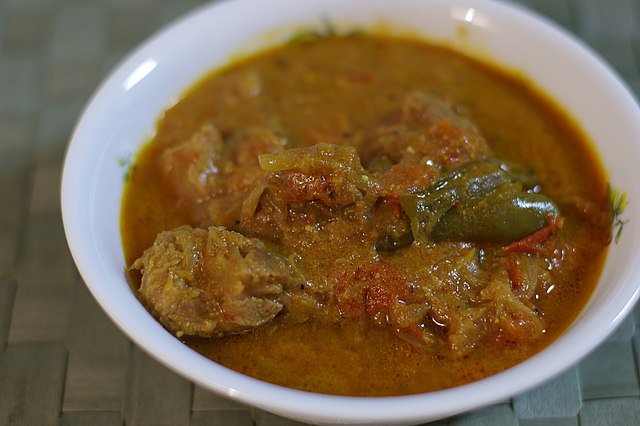
Serves 6
4 tablespoons cooking oil
1-pound ground lean beef or lamb
2 medium onions, finely chopped
4 cloves garlic, crushed
1 teaspoon ground ginger
3/4 teaspoon freshly ground cardamom seeds
1/2 teaspoon salt
1/2 teaspoon cinnamon
1/8 teaspoon cayenne
1 1/2 cups plain yogurt
2 tablespoons finely chopped coriander (cilantro)
1. In a frying pan, heat the oil and sauté meat over medium heat for 10 minutes, then stir in the onions, garlic, ginger, cardamom, salt, cinnamon, and cayenne and sauté for further 20 minutes, stirring every few minutes.
2. Stir in the yogurt and coriander leaves, then remove from the heat and serve immediately.
Cardamom Flavored Rice Pudding
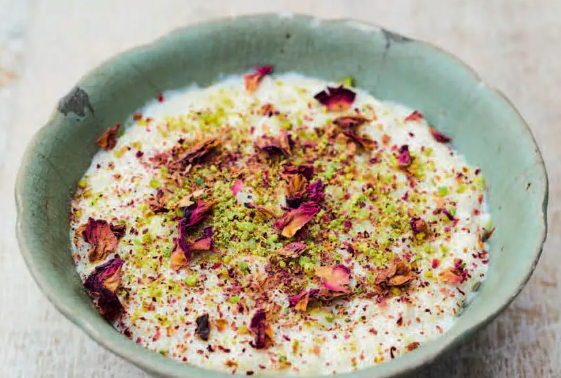
Serves 6
3 1/2 cups milk
1/3 cup white rice, rinsed
1/3 cup sugar
1/4 cup raisins, rinsed
1/2 teaspoon almond extract
1/4 teaspoon freshly ground cardamom seeds
2 tablespoons crushed pistachios
- Place all the ingredients except the pistachios in the saucepan and stirring every few minutes bring to a boil, then cook over medium-low heat for 30 minutes, stirring frequently.
- Place in pudding cups and allow to cool for 5 minutes, then sprinkle with pistachios and serve while warm.
Cardamom Cookies
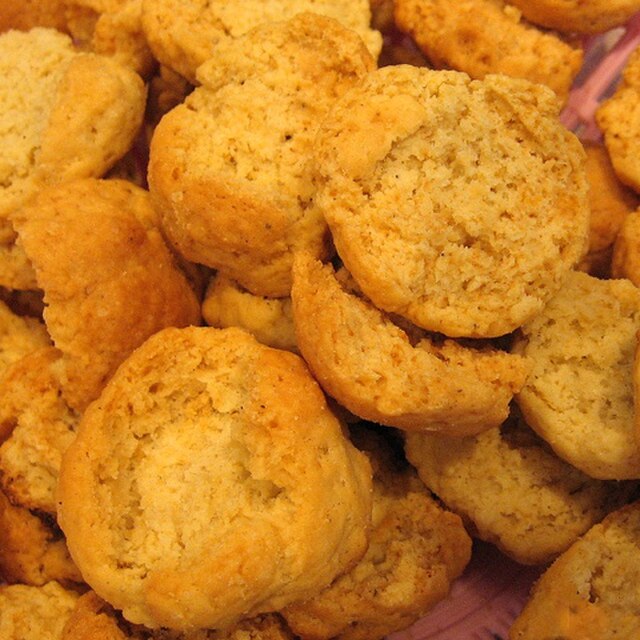
Makes about 45 cookies
2 eggs
3/4 cup butter
1/2 teaspoon almond extract
2 cups flour
1 cup sugar
2 teaspoons baking powder
1/2 cup pulverized blanched almonds
1 teaspoon freshly ground cardamom seeds
1 teaspoon cinnamon
- Place eggs, butter, and almond extract in a blender, then blend for a minute and set aside.
- Combine all the remaining ingredients in a mixing bowl, then slowly add the blender contents while kneading into a dough.
- Form into walnut size balls, then flatten on greased cookie sheets to about 1/4-inch thickness.
- Bake in the 350o F preheated oven for about 12 minutes or until the cookies lightly brown.


